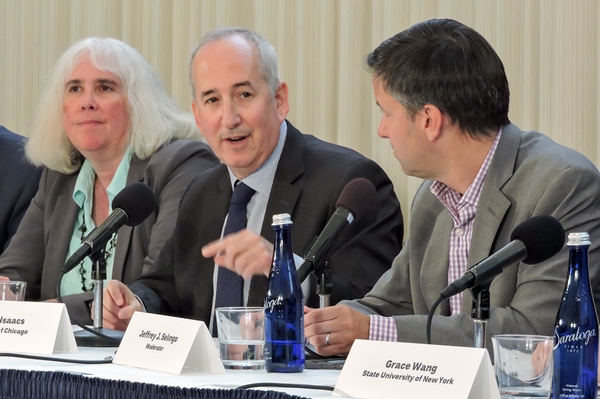
State of American Science panel members, L-R, Jeanne Hossenlopp, Eric Isaacs, and moderator Jeffrey Selingo (A. Kotok)
12 July 2017. A panel of research executives from American universities said the current hostility to immigration in the U.S. is causing fear among many researchers and could have a serious impact on science. Immigration and proposed large cutbacks in funding for overhead costs were among issues causing the most concern for 11 university research officers, assembled at a press conference today by The Science Coalition and Association of American Universities to discuss the state of American science.
In response to a question from Science & Enterprise, panel members expressed fears that steps taken by authorities and hostility against immigrants by individuals could disrupt research at their institutions. Suresh Garimella, executive vice-president for research and partnerships at Purdue University in Indiana, said a large percentage of its faculty is from overseas, as are 1 in 4 students. He added that many universities are in similar situations on their campuses, and unless they communicate the important contributions of immigrants and all the benefits that would disappear, “this will be a disaster.”
Eric Isaacs, vice president for research, innovation, and national laboratories at University of Chicago said that immigration crackdown could have a “damning effect on attracting talent.” He noted that his university is responsible for two national laboratories — Argonne and Fermi national labs — both during research on an international scale, requiring collaboration with scientists worldwide.
Jeanne Hossenlopp, vice president for research and innovation at Marquette University in Milwaukee, warned that the hostile climate towards immigrants, not just the Muslim ban, was causing fear among its researchers. She added that the real impact won’t be seen until the Fall.
Denis Wirtz, vice provost for research at Johns Hopkins University in Baltimore, expressed concerns about that institution’s foreign students returning in the Fall. “The best international students have options,” said Wirtz, adding that countries like France are making overt attempts to steal away top foreign students at American universities.
Proposed cutbacks on research overhead payments
Another topic worrying research executives is proposed elimination of support for research overhead, costs of goods and services supporting research activities overall at an institution rather than attributed to a specific project. While the topic seems at first to be an arcane accounting matter, the scale and purpose of the proposal are raising alarms.
At a congressional hearing in March, Health and Human Services Secretary Tom Price said the Trump administration would pay for a $5.8 billion cut at National Institutes of Health by eliminating overhead payments to universities and research institutes. Last year, according to Science magazine, NIH paid $6.4 billion in overhead, about 27 percent of its research spending.
Daniel Lowenstein, vice chancellor and provost at University of California in San Francisco, pointed out that these funds pay for an institution’s research infrastructure, and if cuts of this scale go through, “it will destroy science.” Isaacs added that unlike companies that do research with short-term payoffs, universities conduct research with benefits for extended periods of time. He cited the Manhattan project in World War II to develop the atomic bomb as an example of long-term science that benefits national security.
Despite mixed support, at best, for science from the federal government, a number of research executives are finding individual states and cities are stepping up for research. Grace Wang, vice chancellor for research and economic development for the State University of New York system, said in New York and other states like California, the state government is increasing its support for clean energy. Isaacs noted mayors often are interested in local activities of universities, and good vehicles for involving the private sector.
The first part of the discussion centered around ways of better communicating the benefits of science, particularly academic science, to office holders and the public at large. UC San Francisco’s Lowenstein offered a succinct summary of those benefits, noting that the partnership between academic science and federal government is “one of the most spectacular successes of our country.” Lowenstein added, “We’re a beacon to the rest of the world. No one does it better than we do. This is what makes America great.”
More from Science & Enterprise:
- Precision Medicine, “My Hope for the Future”
- Science Org. CEO: Trump Order “Contrary to Science”
- Another Chance to Get Serious on Drug Pricing
- Drug Pricing Reform Even Big Pharma Might Like
- The Next Health Care Disruption
* * *

 RSS - Posts
RSS - Posts
You must be logged in to post a comment.